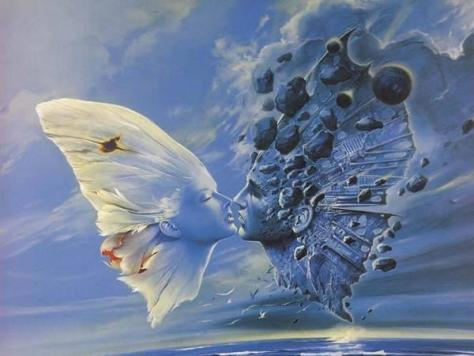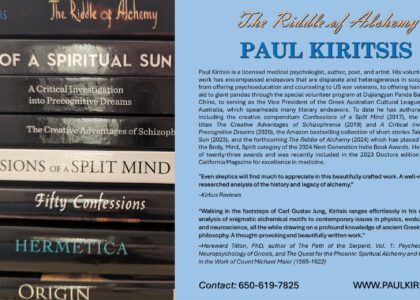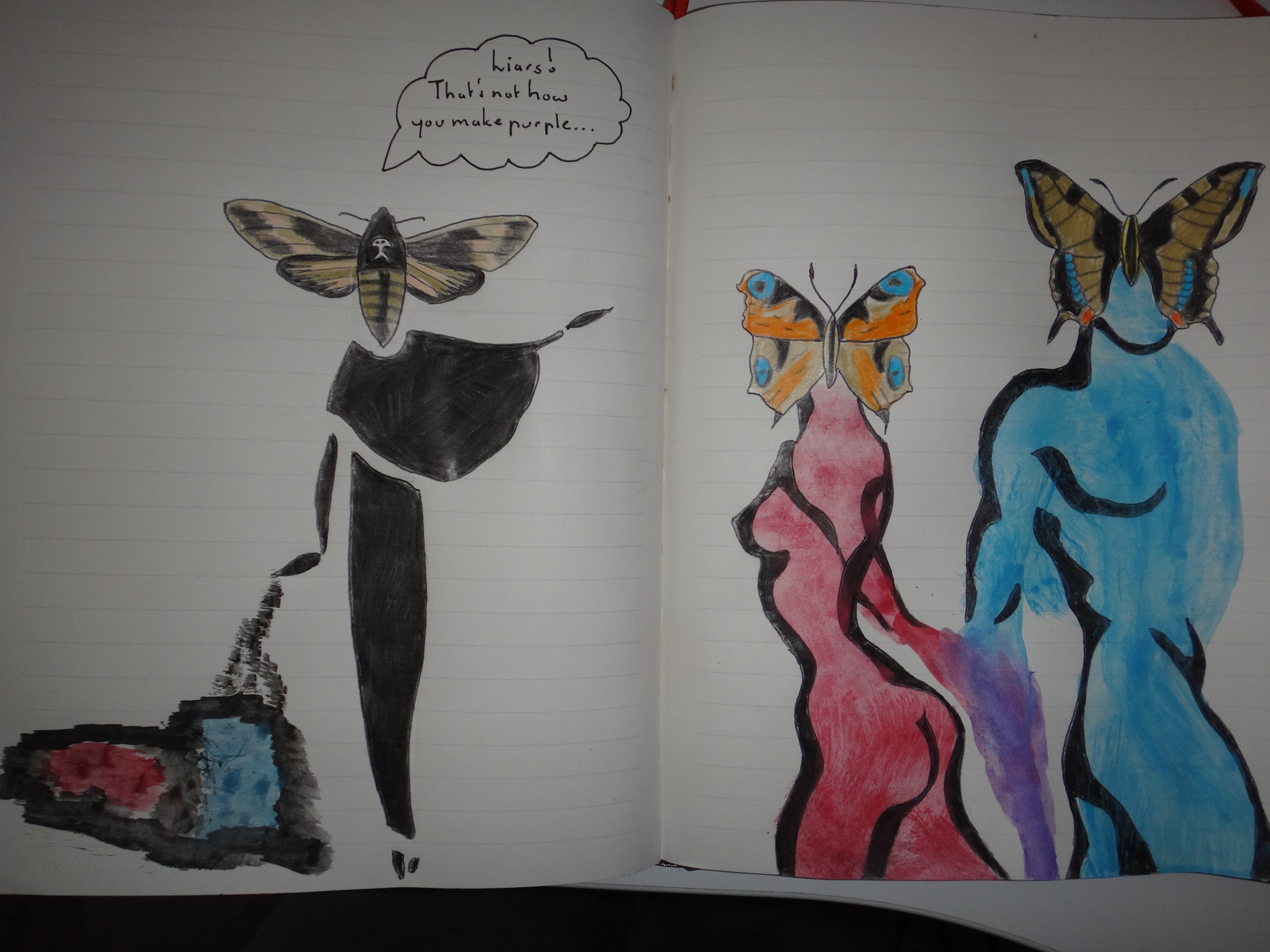
Other than adding credibility to the Hermetic tenet of “what is above is like that which is below”, the said experiments introduce alchemical esotericism into the cosmological equation as foremost of the methods through which Minoan consciousness and its foreign modes of thought might be interpreted. Alchemy itself remains an entirely holistic and humanistic science which uses metals, their properties and chemical transmutation to delineate seven levels of consciousness and the manner whereby spirit becomes matter. In studying alchemical treatises where continual cycles of dissolutions and coagulations or a prime substance (or prima materia) is supposed to produce the Philosopher’s Stone, two images which continually crop up are Sol and Luna.
The Sol principle can be heat, red, sun, light, youth, gold, east and fire; Luna, on the other hand, can be moon, silver, green, white, ocean, age and ocean. In a labour-intensive process that involves repeated distillations of the prime matter in the alembic of the alchemist, the level of refinement attained is revealed through each union or reconciliation of the Sol and Luna principles. Hence the form which these two principles assume changes with each conjunction and reveals in chronological and ascending order the couplings of hen and cock, dog and bitch, a red man and white woman, and finally, the Red King and White Queen. The last of these signifies the culmination of the Great Work. In a Chinese Taoist text titled The Secret of the Golden Flower, Sol and Luna are vociferously clad as a celestial cloud demon and corporeal white ghost. Carl Gustov Jung (1875-1961), who spent many years brooding upon the hidden meanings and apocryphal image-based language of alchemy, interpreted them as the masculine anima and the feminine animus, the archetypal contents of the human psyche. It stands to good reason that Jung’s understanding of alchemy as an unconscious transcription of the individuation process should not be doubted, but on the whole it’s slightly one-sided and monocular. Jung was introduced to alchemy at a time when his theories on the collective unconscious and the archetypes were instigating a full-fledged intellectual revolution, a fact which no doubt prejudiced him towards a purely psychological interpretation and limited his cosmographical scope.
Hence if we jettison Jung’s somewhat reductionist perspective, we see that Sol and Luna are merely metaphors for the concepts of form, the active and spiritual power that seeks expression, and hyle, the wholly passive undifferentiated substance that mirrors water in that it is formless yet at the same time forming. The two principles incarnate as polarities on the cosmic totem pole, with the latter reflecting the true nature of the former. Their conjunction or chemical marriage if you like, occurs at the fundamental and cardinal level of existence from where it ascends to encompass sentient, conscious and transcendental modes of being. Let’s proceed with a tangible example, using the generative forces of Mars and Venus as our prima materia for Sol and Luna, respectively.
At the elementary level the energetic Martian red mixes with harmonious Venusian green to materialise brown, the colour of earth. When they acquire metal form, they unite to form copper-iron pyrites deep in the cavernous depths of the earth’s crust. In human metabolism, these metallic constituents work in symbiotic harmony to produce haemoglobin and determine the sex of a child. In a striking observation reminiscent of the alchemical opus, the metallic form of the generative powers is sex-linked and their personalities are best comprehended when juxtaposed. Evolving onto a more physiological level, they are the male and female gender yet they are also the two hemispheres of the brain united by the corpus collosum. Here, in the most complex piece of matter in the universe, Mars is the dominant sphere, the left, from where he proceeds to orientate himself to the cosmos through deductive reasoning and logic. Alternatively, Venus is the non-dominant hemisphere, the left, and her intrinsic powers of intuition allow her to experience reality as a fundamental unity.
From what has just come to light the formative forces of Mars and Venus, a random marker for the alchemical Sol and Luna, do in fact interact like partners in a marriage where one is active and domineering and the other is passive and unassertive. Further still it wouldn’t be wrong to say that this chemical marriage is eternal and entirely indigenous to all planes of existence, unable to enter into history or change. If we were to transpose everything to the psychic level, to the level of thought, then we would no doubt come to the realisation that the masculine aesthetic as defined by Sol is the will to differentiate and dominate Mother Nature whilst the feminine aesthetic, or Luna, aches for reunification and wishes to connect with her on the broadest levels. By quantifying the characteristics that define the formative, opposing forces of Sol and Luna on the cosmic totem pole and applying them to the spectrum of human consciousness and to the inward realm of the human soul, we can at once see with the eyes of the Minoan astronomer-priestesses and recapitulate a starry world that was wholly under the spell of two feminine powers.
Using the law of analogy, we might think of Bronze Age Cnossos as a deep sea organism like an octopus whose respiratory system is mediated by a copper molecule instead of the fiery and restless iron-based haemoglobin, hence enabling it to enjoy a far more tranquil mode of existence. Had we disembarked here from the Grecian mainland during the Protopalatial Period, we would have seen an unfortified Herculean edifice rising out from the kill of Kephala as a man-made mountain phosphorescing in opalescent silver when struck by the rays of the noonday sun. The decision on the part of the astronomer-priestesses to leave the temple-palaces unfortified has nothing to do with ignorance or apathy and all to do with a genuine inability to perceive transcendence through domination, an entirely masculine aesthetic enterprise and approach to life.
It’s more than likely that the sheer size and scope of the Cnossian temple-palace would have been mesmerising, if not overwhelming. Many of its small, narrow rooms would have served as multi-purpose storehouses for the needs of a living populace. Logically, the primary values of the aesthetically feminine are friendship and love, virtues that reconcile the bonds between spirit and matter, mind and body, but more importantly so, strive for the betterment of a communal egregore without destroying or being detrimental towards other extensions of life. Extreme focus on communal spirit rather than the transitory and corruptible state of personality would have drawn their attention away from the inevitable phenomenon of individual death. Nowhere among the Minoan temple-palaces do we see remnants of mortuary temples erected to preserve individual memories or accomplishments of a royal figurehead or priesthood for the sake of posterity. There are no tombs tucked away in obscure valleys intended to preserve material wealth for use in successive lifetimes either.
There would have been no shortage of stimuli or vivid iconography at Cnossos either; numerous vestibules would have been lined with red and black pillars and decorated with frescoes depicting bulls, oxen, griffins, and other mythological creatures, all of which would have been painted over with rusty reds, golden yellows and azure blues. The avid use of the three primary colours in Minoan visual art delineates a celebration of the vital qualities and a harmonious orientation of their collective psyche towards both positive and negative aspects of Nature as to reflect a complete absence of anxieties. This is the reason why one might see the priesthood engrossed in activities which to our untutored minds seem outrageous and life-threatening, as is the case with the Toreador Fresco which immortalises an acrobatic stunt enacted during a bull-grappling ritual and adds to the mystique and elegance which surrounds the Minoan culture. It might also be worth mentioning here that maintaining the cosmic order through ritual was sacrosanct, taking precedence over individual fate and the preservation of human life. Any resistance or attempt to alter the trajectory of a wholly divine enterprise constituted a rude attempt to alter cosmic justice and transcend Nature–something which appears to have precluded Minoan cosmology at all times.
In addition, it should also be noted that the war element on Minoan frescoes is strikingly absent. There are no depictions of soldiers, no stern-faced monarchs. This shouldn’t be the least bit surprising considering the nature of the powers at work in Minoan consciousness. The lunarised powers working through human beings and Mother Nature herself warn against the dangers of transcendence. Much to the detriment of feminine aesthetic consciousness, these collective thought forms arrest the evolution of universal brotherhood and love by generating social hierarchy and conventional marriage, institutions which preclude the qualities of trust and empathic mutuality. In turn, the unconscious suppression and distortion of these forms of truth quickly breed ignorance, prejudice and eventually extirpates life through the cycle agent of war. Therefore any continued pursuit that attempts to attract to itself the polarity of vainglory and nobility through masculine aesthetic consciousness will not only spur devolution but will continue to devastate the powerful, spiritual forces of true love and friendship–qualities conductive to the survival of life itself.
Having established the Minoan preoccupation with the mysteries of life in the fullest sense of the word, we can now see why the astronomer-priestesses of Cnossos imagined their goddess to be a bee, or a bee-like entity. Bees are, for the most part, mutually cooperative in their communal habits and tireless in their striving to recapitulate the process of creation ex nihilo
Indeed, everything does return to the divine and sacred source through the agent of love…








